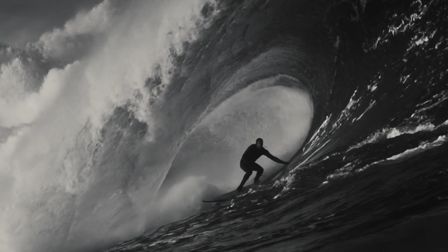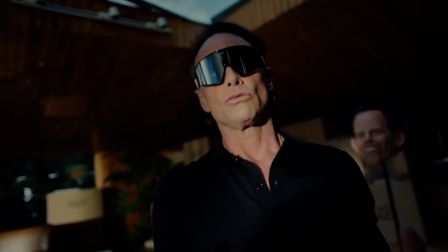Toby Dye Takes Ford Back to Black on Sub-Zero Svalbard Shoot
Shot in the world's northernmost town, 100 Days of Dark showcases the tough capabilities of Ford's Ranger Black Edition through the lives of the hardy folk who live there.
Credits
powered by
-
- Production Company RSA Films
-
-
-
Unlock full credits and more with a Source + shots membership.
Credits
powered by
- Production Company RSA Films
- Location Service Jason Roberts Productions
- Post Production Gramercy Park Studios
- Music Rebel Rebel
- Editor Julian Eguiguren
- Director of Photography Jasper Spanning
- Art Director Louise Shaw
- Copywriter Alexander Smith
- Agency Producer Aaron Clark
- Agency Producer Max Dinunno
- Executive Creative Director
- Chief Creative Officer Julian Watt
- Director Toby Dye
- Producer Emma Cairns
- VFX Supervisor Stephen Miller
- Associate Creative Director Marcos Almirante
- Colourist Ben Rogers
- Sound Designer Toby Griffin
- Music James O'Connell
- Post Production Producer
- Post Production Producer
- Post Production Producer Annika Gustavsson

Credits
powered by
- Production Company RSA Films
- Location Service Jason Roberts Productions
- Post Production Gramercy Park Studios
- Music Rebel Rebel
- Editor Julian Eguiguren
- Director of Photography Jasper Spanning
- Art Director Louise Shaw
- Copywriter Alexander Smith
- Agency Producer Aaron Clark
- Agency Producer Max Dinunno
- Executive Creative Director
- Chief Creative Officer Julian Watt
- Director Toby Dye
- Producer Emma Cairns
- VFX Supervisor Stephen Miller
- Associate Creative Director Marcos Almirante
- Colourist Ben Rogers
- Sound Designer Toby Griffin
- Music James O'Connell
- Post Production Producer
- Post Production Producer
- Post Production Producer Annika Gustavsson
Pity the director and crew on Ford's latest campaign. While most car shoots involve heading off to Cape Town or similarly sunny climes, they were packing their thermal vests and long-johns in preparation for one of the most inhospitable places on earth: Longyearbyen, Svalbard, Norway - the world's northernmost town.
Created by GTB London to promote Ford's Ranger Black Edition, the resulting film, 100 Days of Dark shows just how tough life can get in the Arctic Circle during the polar night.

Shot by Toby Dye and produced by RSA Films, the main film of the campaign revolves around three drivers who live in Longyearbyen. For over 110 days, they live and work in temperatures of -20º and complete darkness. It's not a place for everyone (and certainly doesn't appeal to team shots, who are already looking forward to sun-drenched afternoons on the Croisette). But the extreme terrain and conditions do seem to be the perfect fit for the Ranger Black Edition, which is shown zipping round treacherously icy roads and traversing mountainous landscapes with ease.
Below, we caught up with Dye to discuss the production perils of shooting in the extreme Arctic conditions.
Toby Dye, director
.jpg)
Shooting on location when it's below freezing and pitch-black for 24 hours a day doesn’t sound like the most appealing gig… what were your first thoughts on receiving the script and what appealed to you about it?
My first thought was: ‘I have to do this.’ It was one of those perfectly pure concepts – take a tough, totally black car and put it in an insanely tough, black environment – that does not require over-explaining, which in turns opens up a lot of very rich visual and thematic possibilities. Two aspects particularly appealed me. The first was the opportunity to explore a black on black aesthetic, something I have been keen to do for a while. I knew that filming a black car against the blackness of the polar night would throw up lots of creative opportunities for really interesting photography. The other draw was thematic. I love exploring counter-intuitive viewpoints in my films and what could be more unexpected than to showcase people that love the darkness. I thought wouldn’t it be interesting to hear from them? I figured if you’re going to find someone like that anywhere, it would be in a place that is dark three months of year, and sure enough we found them in Svalbard.

What were the biggest technical and production challenges involved in filming in such extreme conditions? Had you ever worked in that sort of environment before?
My better half is Icelandic, and I have filmed over there before, so have some experience of shooting in very cold conditions but really nothing could have prepared me for Svalbard. The biggest production challenge was just dealing with the cold. You had to put on so many layers of clothing just to walk outside that it took 15 minutes each time anyone entered or exited a building. Also, the darkness played havoc with everyone’s internal clocks. By midday everyday it would feel like it was midnight and the whole crew was flagging, but we would then pick up again after lunch.

What sort of kit did you need?
Surprisingly we didn’t need too much specialist kit – we just made sure everything was as pared-down and simple as possible so there wasn’t too much to go wrong. We shot with Alexa Mini, Black Magic Pocket and a drone, and it was all available light, nothing was lit. This was a creative choice, but was just as well really as we had a pretty low budget, so couldn’t have afforded lighting if we’d wanted it anyway! Similarly, neither could we afford some of the other bells and whistles that traditionally go with car films, most notably a Russian arm, but even if we could have it would have been debatable if it would even function in that environment, so we had to think creatively about how to shoot the car with a stripped back kit list. We opted to use a Movi rig – we rigged a camera car with lots of car mounts that we could quickly and simply mount the Movi on, and then operate it from inside the camera car via joystick to avoid being out in the freezing cold too long. This made the shooting much more versatile and fast – if we wanted to shoot non-car material we could quickly take the Movi off the car mounts and shoot with it handheld.

How did you go about finding the hardy souls featured in the film?
That was twofold. We had help from a very well-placed local, an infamous film fixer called Jason Roberts, based there primarily for all the natural history documentary work that is done on the Island. He started the ball rolling with helping us locate good characters. Then in the UK we’d interview potential candidates via skype. Fortunately, Svalbard has incredibly fast internet connections due to it also being the site of an enormous satellite station. The other fortunate thing is that there’s only 2,500 people on the island so there’s not too many people to choose from!

What was the most rewarding part of the job?
On a job where I got to go to the Artic, I know it may sound perverse to say that I enjoyed the edit the most, but it’s true. The edit is always my favourite part of the film-making process and this was no exception. I’ve worked with the same editor, Julian Eguiguren, for nearly ten years and we have a hugely productive working relationship - very open to exploring where the edit will take us based on what we find in the footage, rather than going in with too rigid a plan. This brings out new and unexpected elements that are often better than what we had originally envisaged. For instance, the wonderful semi-abstract imagery the film opens with was the product of some chance footage we got because of the very extreme weather conditions, that we were then able to mould into the opening sequence.
Connections
powered by
- Agency GTB London
- Location Service Jason Roberts Productions
- Post Production Gramercy Park Studios
- Production RSA Films
- Chief Creative Officer Julian Watt
- Copywriter Alexander Smith
- Director Toby Dye
- Editor Julian Eguiguren
- Executive Creative Director Lazaros Nikiforidis
- Producer Emma Cairns
- Post Production Producer Annika Gustavsson
Unlock this information and more with a Source membership.
)










